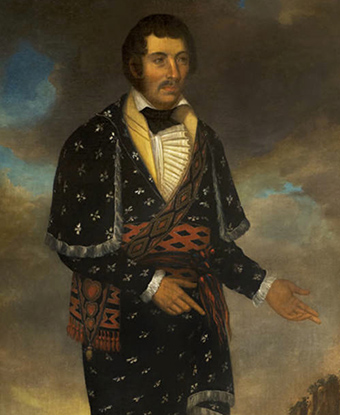After the American Revolution, the Washington administration embraced a program to “civilize” native peoples, transforming Indians from tribal peoples into individuals who could be easily assimilated into American society.
Escalating demands from more and more cessions of Indian land earned white people a new name among the Creeks: ecunnaunuxulgee, “people greedily grasping after the lands of the red people.”

Alabama Department of Archives and History
The civilization program promoted commercial agriculture, Christianity, an alteration in the gender-based divisions of labor among Indians, and, most importantly, private ownership of land. Americans hoped that if Indian peoples settled down to farm life, they would have little need of vast hunting territories and would willingly cede this “excess” territory to Americans. The government also encouraged Indians to run up debts to traders and government stores. Indian debts, which outstripped their ability to pay, could then be settled by sale of tribal lands. Meanwhile, American agents used annuity payments as well as donations from Quakers and other religious groups to purchase plows and spinning wheels in their effort to transform the work roles of native men and women. Women, in particular, were key to the plan, which sought to introduce Indians to cloth production to end the dependence of cloth obtained through trade.
Indians themselves responded to changing economic conditions in creative ways. As overhunting decimated deer herds, domesticated animals, including cattle and pigs, appeared more frequently in the Creek landscape. Communal fields along the rich riverbanks gave way to smaller individual plots as Creek ranchers moved to the uplands seeking pasture for their animals. Cattle, horses, and slaves became as valuable market commodities as deerskins had once been. In southern Creek territory, along the border with the Mississippi Territory, families of mixed-Creek and European ancestry established farms and ferries, and increasingly created private wealth from communal lands. For the Shawnees, the primary focus of the civilization movement was at Wapokoneta, on the upper Auglaize River, where, under the leadership of Black Hoof, Shawnees were tutored by government agents and Quakers. As among the Creeks, the outsiders promoted commercial agriculture, instructed women in the domestic arts of spinning and weaving, and introduced livestock to Shawnee men. With changing economies came fundamental changes in the way men and women viewed themselves. Men, whose fame and self-worth had previously rested on skills as warriors and hunters, now found new outlets for masculine expression via the market and as cattle ranchers. Some Indian women, whose responsibilities had always included the production of finished leather for household use as well as trade, willingly took up the loom.
Although some Indians began to hold new views of work and property, Indian peoples did not abandon their view that all the land was held jointly by their tribes, and even those moving toward commercial agriculture and other pursuits were not inclined to part with the land. American views of private land ownership were at odds with the idea of community ownership. But it wasn’t so much the nature of Indian landholding that did not sit well with white Americans as the fact that the land was owned by Indians, who were viewed as “savage” and racially inferior to white Americans. Escalating demands from more and more cessions of Indian land earned white people a new name among the Creeks: ecunnaunuxulgee, “people greedily grasping after the lands of the red people.”
Part of a series of articles titled American Indians and the War of 1812 .
Last updated: January 6, 2022
